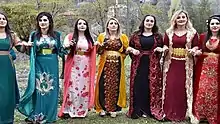Halay
Halay[a] is a regional category of folk dance styles in central and southeastern Anatolia. The music accompanying the dance is the zurna and davul.[1] It begins slow and speeds up.[1] The word "halay" is thought to have been derived from the verbs "hildan" or "haldan" in Kurdish, but there is no certainty on its etymology. There is effectively no text or paper that affirms the existence of the Kurdish word "hilayi," while Kurdish dances are normally known by the name govend or dîlan. [2][3]


| Yalli (Kochari, Tenzere), traditional group dances of Nakhchivan | |
|---|---|
| Country | Azerbaijan |
| Domains | Folk dance |
| Reference | 1190 |
| Region | Middle East |
| Inscription history | |
| Inscription | 2018 (13th session) |
Halay is a traditional dance in Middle East it mostly played during wedding on the zurna, supported by a davul, but in the recent years, electronic instruments have started to replace them. Typically, Halay dancers form a circle or a line, while holding each other with the little finger or shoulder to shoulder or even hand to hand with the last and first player holding a piece of cloth.
The Ohuokhai is a simultaneous round dance and song. Dancers form a circle and dance, arm in arm, hand in hand, with the left foot put forward, while making rhythmical, graceful movements with their bodies, legs, feet and arms. A lead singer improvises the lyrics and the other dancers repeat them. This Ohuokhai leader has a special talent not only for singing but also, what is more important, for poetic improvisation. There song leaders compete at the national Yhyakh festival for the best poetic expression, best song and biggest circle.
Types of Halay
- Dîlan (Kurdish dance)
- Elazığ dik halay (Turkish-Kurdish)
- Assyrian folk dance
- Chobi, an Iraqi folk dance
- Attan, an Afghan or Pashtun folk dance
- Dabke, a Syrian-Lebanese folk dance
- Akdağmadeni halay (Turkish)
- Harkuşta (Armenian)
- Faroese dance, a northern European folk dance
- Horon (Laz)
- Kochari, an Armenian and Kurdish folk dance
- Kolo, a South Slavic folk dance
- Tamzara, Sharur district folk dance
Annotations
References
- Jan Laurens Hartong (2006). Musical Terms Worldwide: A Companion for the Musical Explorer. Semar Publishers Srl. pp. 132–. ISBN 978-88-7778-090-4.
- "Halay - Kelime Etimolojisi, Kelimesinin Kökeni". www.etimolojiturkce.com. Retrieved 2020-07-25.
- "Halay - Kelime Etimolojisi, Kelimesinin Kökeni". 2015-12-27. Archived from the original on 2015-12-27. Retrieved 2020-07-25.
- Sevan Nişanyan, Sözlerin Soyağacı: Çağdaş Türkçenin Etimolojik Sözlüğü (the family tree of words: an etymological dictionary of contemporary Turkish), Istanbul, 2007
